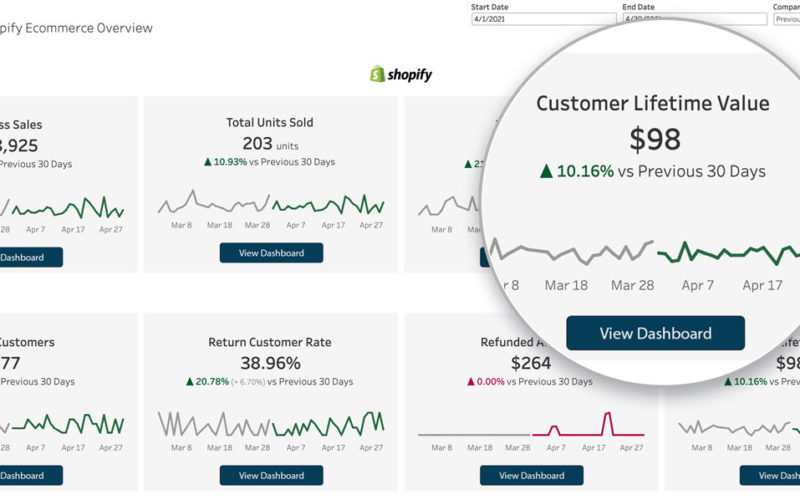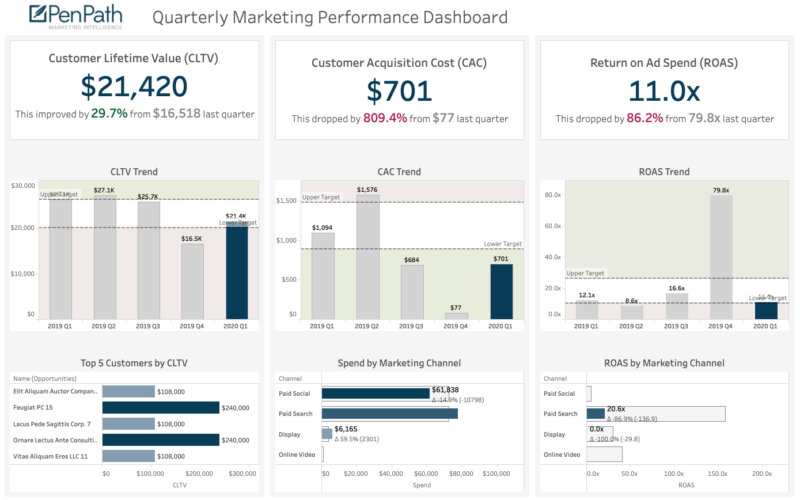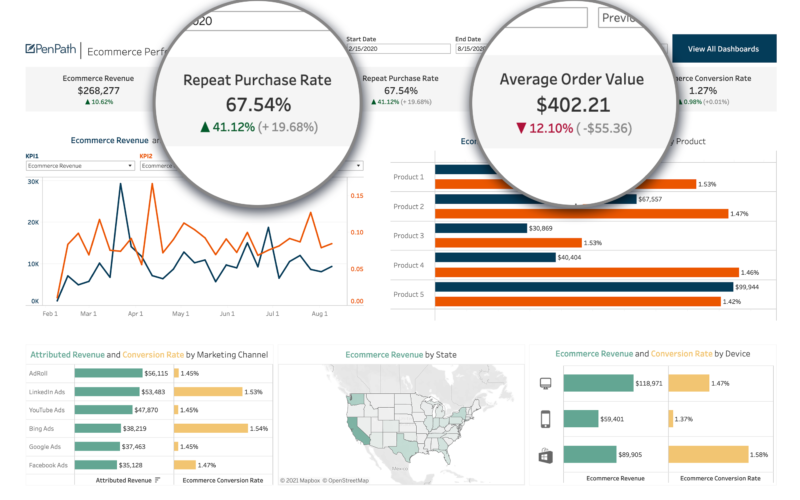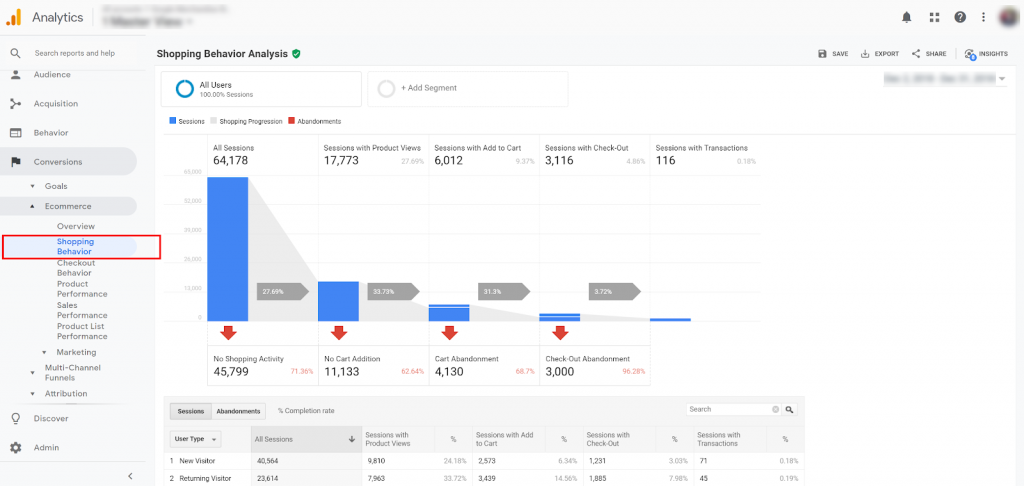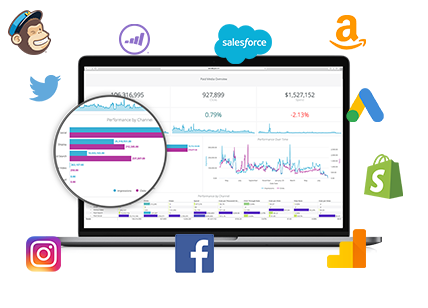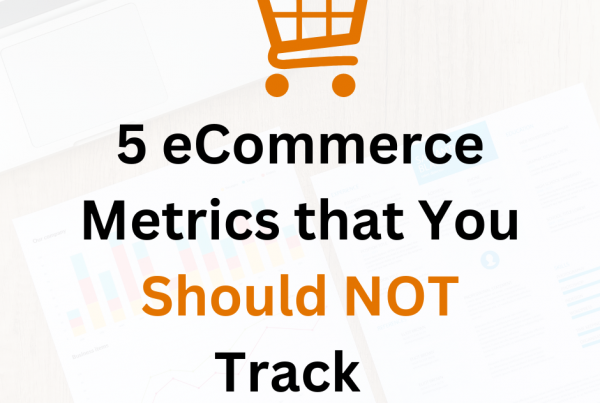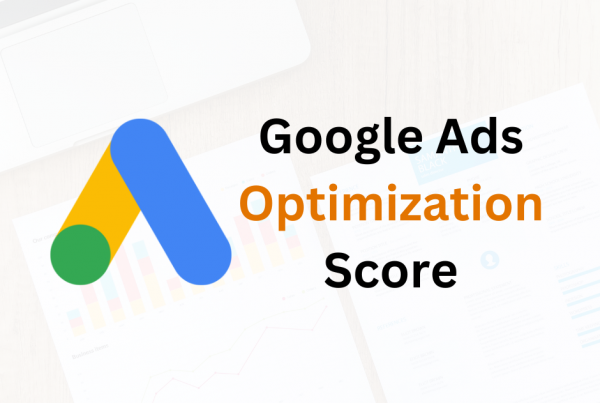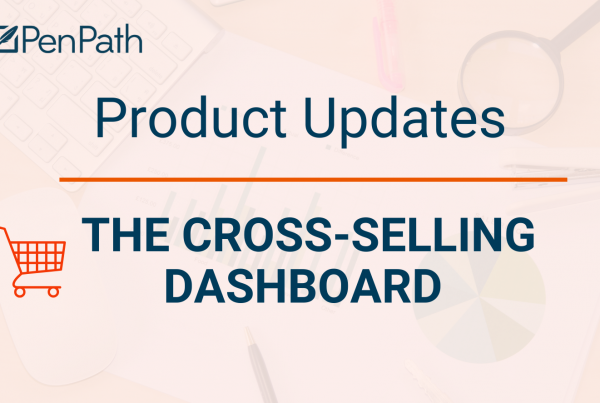At PenPath, we want marketers to understand important metric definitions, where to find common metrics, as well as how they can be combined to yield powerful insights. Below we will showcase Customer Lifetime Value dashboard examples and explain why this is one of the most important marketing metrics you can track.
In our last article, we talked about where to find Ad Cost & Website Session Data on platforms such as Paid Search and Youtube Ads. Now, we’re going to see how we can bring it together on our dashboard with unique calculated metrics.
First though, let’s take a look at the calculated metrics we’ve done and how far we’ve come in our analytics journey.
Table Of Contents
-
- Calculated Metrics Refresher
- Cost Per Website Session
- Customer Lifetime Value (CLV)
- CLV: CAC Ratio
- Dashboard View
- Analysis Exercise
- In Conclusion
Customer Lifetime Value (CLTV / LTV) Dashboard Examples
1. Calculated Metrics Refresher
Some of the calculated metrics we’ve already talked about in this series are:
- CAC (Customer Acquisition Cost) → Total Cost Of Sales & Marketing/# of Customers Acquired
- Revenue – Cost → Return On Ad Spend
Today, we want to talk about:
- Cost From Ad Data/# of Web Sessions → Cost Per Website Session
- Customer Lifetime Value (CLV) → (Average Purchase Value- Average Purchase Frequency) * Average Customer Lifespan
- CLV: CAC (Ratio of Customer Lifetime Value to Customer Acquisition Cost)
Why would we want to calculate those exact metrics though? How would they help a business?
We’ll find out in the next section.
2. Cost Per Website Session
Cost Per Website Session can lead to a better understanding of our marketing. This can also be combined with other web metrics such as bounce rate to determine whether our marketing is actually working. From there we can see which blog posts are the most popular and driving the most traction.
We can also see what ads or channels are the most valuable for bringing people onto the site, and whether they turn into a lead or not. The entire user journey can be seen through funnels in Google Analytics.
An example of a funnel. Source: EasyAutotagging
3. Customer Lifetime Value (CLV)
On top of that, we can see if the users with the longest website sessions turned into customers. From that, we can calculate CLV (Customer Lifetime Value), another important metric in marketing.
There is actually data that shows content marketing boosts CLV, so we have come full circle now. Because it encourages loyalty, CLV might be one of the most important metrics to calculate according to Harvard Business Review.
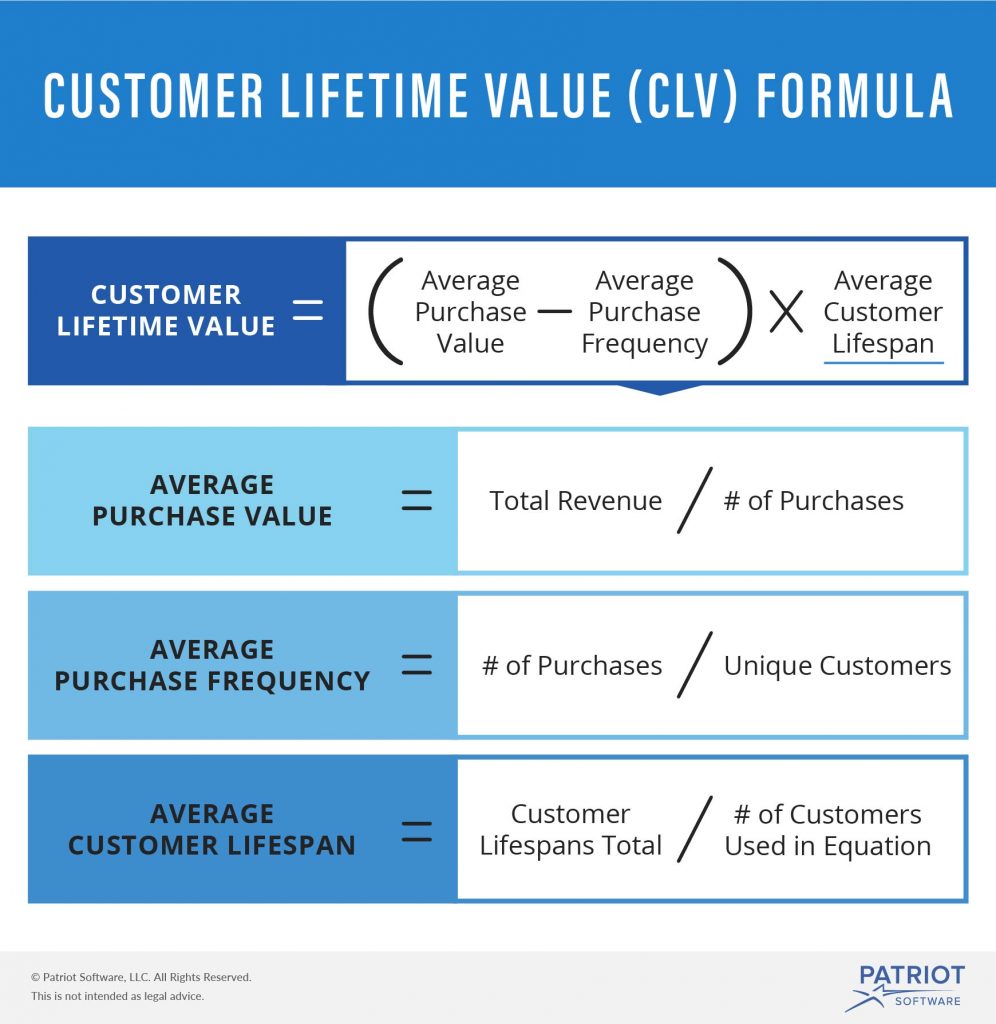 Source: Patriot Software
Source: Patriot Software
4. CLV:CAC Ratio
What else can we do with CLV? We can combine it with CAC (Customer Acquisition Cost) to form a powerful KPI.
In previous articles, we’ve talked about what CAC is as a calculated metric and what information it gives.
Now, we’re combining CAC with CLV to form the CLV:CAC Ratio.
What does this mean?
The Customer Acquisition Cost tells you about how much money it takes to acquire a customer. Customer Lifetime Value says what they are worth over a lifetime.
Based on those two points, you can figure out if your marketing efforts are working or not.
According to Practical Ecommerce, “A CLV:CAC of one to one (i.e., 1:1) tells you that your company is failing. With this ratio, ecommerce growth can only be achieved with significant investment, and you should not expect to earn much profit.
On the other hand, a CLV:CAC ratio of three-to-one or higher indicates that your company is building value. Investing in your business should lead to profitable growth.
There are limits, too. If the CLV:CAC ratio is too high, say 25:1, you are investing too little and may be vulnerable to competition.”
Of course, you wouldn’t want to review this metric everyday, but a 3-month view and 12-month view should be enough to spot trends and patterns.
You can see how data exploration is a bit like playing detective.

The upcoming section is the most exciting one. We’ll see what a PenPath dashboard looks like with some of the metrics above!
5. Dashboard View
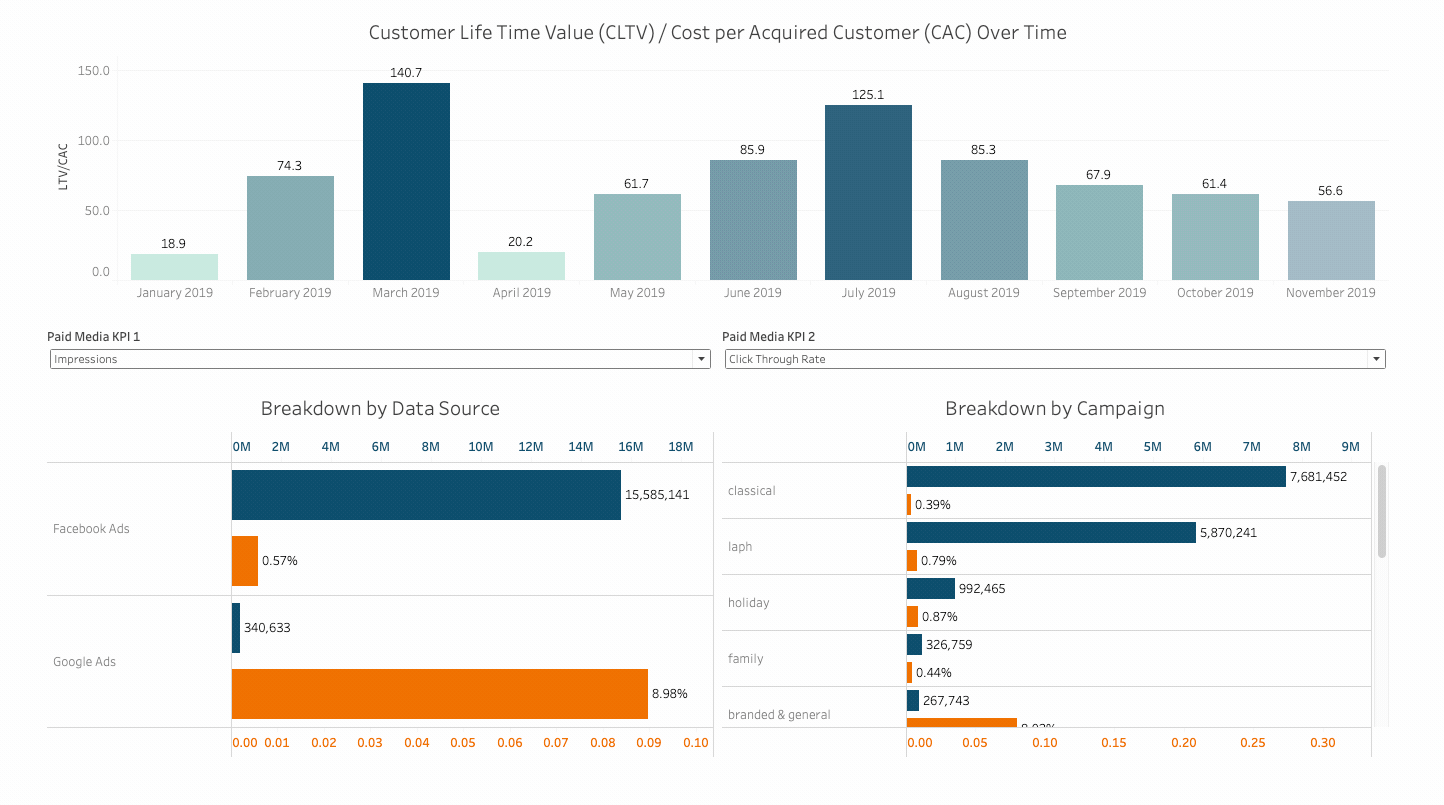 Source: PenPath Customer Lifetime Value Dashboard Example
Source: PenPath Customer Lifetime Value Dashboard Example
PenPath dashboards are unique because they focus on holistic data. You could possibly come up with calculated metrics for one advertising platform. However, if you did want aggregate data, that step would be duplicated for each platform, and then added up.
Think about how much time that would take! Not to mention how to puzzle out the timeframes. What if you wanted to go back monthly, quarterly, and yearly? How would you put that data together?
At PenPath, we take care of those problems for you so you can just focus on the analysis portion. From there, you can create a better marketing strategy to drive business results.
Here are some sample analysis questions to ask from the calculated metrics we’ve discussed above. Let’s go over the CLV:CAC questions first.
6. Questions To Ask
CAC:CLV Ratio Metric:
- In which month is my ratio highest? What does that mean?
- Is there a downward or upward trend throughout the months?
- What 2 KPIs do I want to choose to see changes in my ratio? Does it even change?
- What marketing strategies do we need to improve based on this?
If we had a customer lifetime value dashboard with just “CLV” or “Cost Per Website Session” (yes, that’s possible with PenPath!), then we could ask these questions too. You can see how drilling down into details becomes possible when custom dashboards are an option.
We could even separate analysis questions by the role of the person who’s looking at the dashboard. Maybe making dashboards based on each person’s need-to-know information could be an option?
Customer Lifetime Value Metric:
- Marketing: What’s the most you should spend to acquire a new customer?
- Sales: Which prospects should I be spending my time with and working to close?
- Product: How to best align my products/services to match my ideal buyer?
- Customer Service: How much should I be spending to keep and support a customer?
Cost Per Website Session Metric:
- Are we paying too much for each website session based on ads?
- Which ad channel is the most costly?
- Do users come in from a specific sponsored post but find that another one resonates with them more?
- Are lead pages or blog posts more popular?
- Which ones lead to transactions?
Hopefully, the questions above give some sort of direction in terms of analysis. There’s so many more you could brainstorm as well!
7. In Conclusion
At the end of the day, this is why a Marketing Intelligence solution like PenPath works. Instead of focusing on being a number cruncher, you can give that time to improving your marketing strategies and campaigns.
Not only that, but you get high-level insights you wouldn’t be able to get on your own, as well as dashboards tailored to your business needs.
For a live example, book a demo with PenPath today. We’ll show you many more cool ways you can look at your data. Being marketing strategists as well as data experts, we’ve helped many businesses take their data analytics to the next level.
Otherwise, keep on reading for more insights into everything data analytics, business intelligence, and digital marketing!

